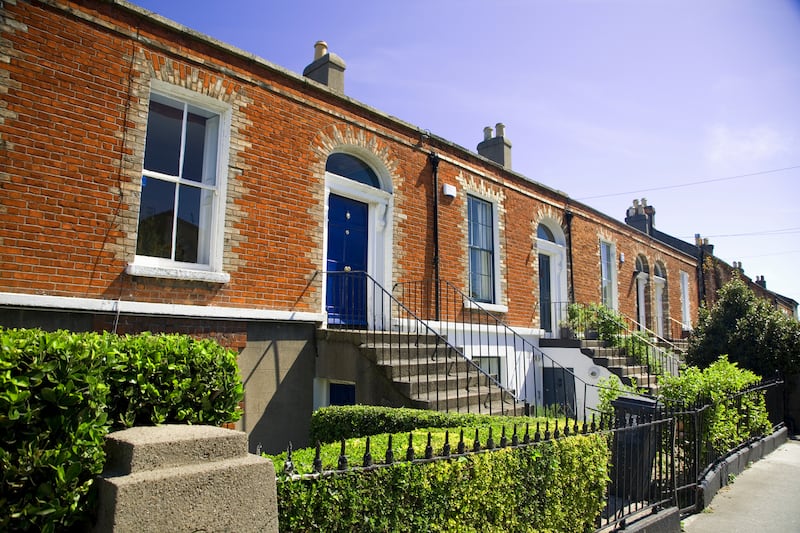The Sustainable Energy Authority of Ireland’s (SEAI’s) home energy grants scheme has been immensely popular. Last year it had 67,400 applications with 47,900 home energy grants funded, of which 17,600 were brought up to a B2 Ber rating.
But pity the owners of those homes that didn’t qualify. With about 16 per cent of the State’s housing stock excluded from the current model, the SEAI’s new Traditional Homes pilot scheme is likely to be welcomed by those who own older homes.
Traditional-style buildings are those constructed using natural materials such as stone, brick or clay, and tend to have been built before the 1940s. This umbrella term covers many period properties, from Georgian town houses and workers’ cottages to traditional farmhouses and country piles.
The purpose of the pilot scheme is to provide data to the SEAI so it can work out a compliance mechanism that will allow the works required to upgrade traditional homes to conform to the existing building regulations. This, in turn, will allow for grant aid to be provided for the types of materials that need to be used to upgrade them to perform more energy efficiently.
READ MORE
When it comes to retrofitting such homes, a different approach is required, says Brian McIntyre, programme manager at the SEAI. A key difference between traditional and modern construction is in the way moisture transfer in internal walls is managed. Traditional materials and construction techniques allow for the natural movement of heat and moisture. The walls rely on their thickness to cope with atmospheric moisture, and on being sufficiently deep to ensure that drying out takes place before external moisture reaches the inner face of the wall.
“The problem is that the wall insulation materials that are certified are not suitable for traditional building walls and the materials that are suitable are not certified,” says McIntyre.
“The materials used for traditional buildings need to be breathable. Before the pilot and in all other schemes, the requirement for wall insulation is that the insulation should have Irish Agrément certification, typically issued by the National Standards Authority of Ireland. However, the materials currently certified are not suitable for traditional buildings for the most part,” he says.
In an effort to bring traditional homes in from the cold, the SEAI has been liaising with conservation bodies to find a way to include them in its existing scheme. “The pilot won’t be requiring that the materials have that certification. The materials used will be as specified by the traditional building professional,” says McIntyre.
[ The debate: Is a heat pump a good investment for your home?Opens in new window ]

Taking part
To qualify for the pilot scheme you will need to already have engaged the services of either a heritage architect, a chartered building engineer or a chartered building surveyor.
Why? Because only members with Royal Institute of the Architects of Ireland (RIAI), Engineers Ireland or Society of Chartered Surveyors accreditation can sign off on the recommended materials and works in accordance with the regulations and relevant local authority building control, McIntyre says.
It is these professionals who will recommend suppliers who will have their own registered contractors trained to use their products. This will ensure that the correct procedures and products are used.
To go through the scheme, the homeowner and traditional building professional will need to engage the services of one of the SEAI-approved one-stop shops, McIntyre says. The body is compiling a list of participating companies, however, the list will not be a static one as more companies signal their interest to participate.
With a lot of grant applicants wanting to include extensions and renovations with their retrofit and often using different building teams on site, the idea of engaging one of the aforementioned professionals was to try to co-ordinate the works properly and avoid using building materials not suited to the property type, according to Deirdre Keeley, a conservation architect and assistant practice director at the RIAI, members of which worked with the SEAI on the pilot scheme.
“It’s about a fabric-first approach, about getting a healthy building structure that is certified by professionals and will add value,” she says.
Interested homeowners can apply now through the one-stop-shop service on seai.ie.
Costs
Home Comfort Retrofits, based in Kilcock, Co Kildare, for example, is a company with expertise in traditional buildings. Having access to the grants is welcome, says Richard McCarthy, its quality and training manager.
In a more contemporary build, the wall insulation options are relatively affordable, McCarthy says. In contrast, “however, the relevant insulation methods that work on traditional homes will cost 1½ and 2½ times the price of insulation on a more contemporary build”.
Graham Kavanagh, managing director of Modia Consulting, a chartered quantity surveyor and project manager firm, agrees.
He illustrates the point with an example that is based on two interior wall insulation options for a two-storey, detached house, that has 114 sq m of floor area and ceiling heights of 2.4m. He estimates the internal wall area to be insulated would be 137sq m.
One of the preferred traditional buildings approach requires the removal of the existing render and to re-render using, for example, 60mm of Diathonite lime render, a breathable mixture of clay and cork particles. On a property of this size, this would cost in the region of €35,693 excluding VAT. A slightly more affordable option would be to use an IQ Therm breathable drylining system, which for a comparable house size would cost about €27,456 excluding VAT.
The most affordable option that builders and professionals recommend for modern constructions features battens and 92.5mm insulated plasterboard with a skim finish. Its comparable cost is about €12,420 excluding VAT, a lot less than the traditional building approach.
Diathonite is only one possible traditional building approach. Other options include wood fibre and hemp.
“The Diathonite will also take considerably longer to dry and as such would add to preliminary costs such as on-site, time-related costs like insurance and supervision,” says Kavanagh. This will amount to nearly three times the cost overall, he says.

A traditional home can avail of the internal insulation grant, which ranges from €1,500 for an apartment to €4,500 for a detached house, or the external insulation grant, from €3,000 to €8,000; they’re not limited to internal insulation, McIntryre explains. “If the traditional building professional specifies external wall insulation as part of the pilot works, then the external insulation grant will apply.”
But the cost differential between the grant and the outlays the homeowner will have to make are sobering. Will these increased outlays be reflected in the level of grant aid available to owners of these sorts of homes? The short answer is no. At least for now.
McIntyre fully accepts the cost differential. However, he says the fact that it is more expensive to insulate older homes won’t be reflected in the grant amount for the pilot scheme.
But bringing this kind of housing stock into the grant scheme is a move in the right direction, nevertheless. “It’s to use the existing mechanism that’s there,” he explains. “Trying to understand the level of costs and the different costs for different floor areas will allow us to make them more proportionate.”
For now, it is a good but small first step, says Peter Cox, managing director of Carrig Conservation, a specialist consultancy. He says the aim is to prove over the term of the pilot that giving grants to older buildings goes some way to contributing to reducing carbon emissions.
“If we upgrade any building older than 1950 it has a cultural significance to our cityscapes, townscapes, villages and rural Ireland,” that too has merit, he says.
It’s not a perfect solution, McIntyre says, but it is a start. “We can’t leave a quarter of a million households to upgrade holistically,” he says.
*Article updated at 4pm on October 24th, 2024














